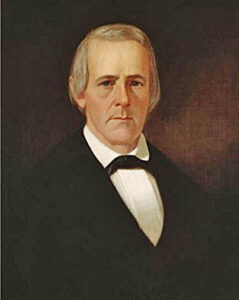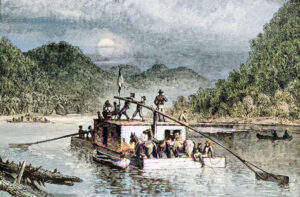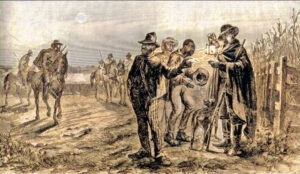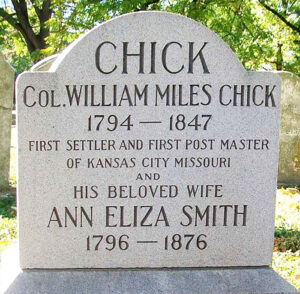William M. Chick was a Kansas City, Missouri pioneer, founder, merchant, and first postmaster.
William Miles Chick was born August 31, 1794, on a tobacco farm near Lynchburg, Virginia. While growing up, he helped on the farm and, during his early adulthood, worked as a merchant in the Alexandria, Virginia, area. He received the commission of colonel from the Governor of Virginia during the War of 1812. He was ordered to raise a regiment of volunteers to fight the British; however, the war ended before he and his men saw action.
In 1816 he married Ann Eliza Smith from Alexandria, and the couple would eventually have eight children.
In 1822, the family moved to Missouri, where Chick’s father-in-law had acquired land. They traveled by wagon train to Pittsburgh, Pennsylvania, with their household servants and slaves. Upon arrival, they loaded their belongings onto flatboats and floated nearly 600 miles down the Ohio River to Shawneetown, Illinois. From there, they again traveled by wagon to St. Louis, Missouri, where they re-supplied before continuing overland to Saline County, settling in what would become Arrow Rock, Missouri.
Along with his slaves, Chick worked that winter to clear the land of densely growing cottonwoods and used the felled trees to build themselves log cabins for shelter.
Saline County’s residents came from slaveholding states, and there was a reasonably large slave population in the area. Though no town had been formed, the area residents gathered to appoint “patrollers” to ensure that enslaved people were being watched closely. In 1824, William Chick was one of three patrollers appointed.
In the summer of 1826, the Missouri River flooded, sweeping houses and crops away, including the Chick cabins. He then moved his family across the river to Howard County and established a new farm. There he grew tobacco and fared much better for the next decade.
However, in 1836, he moved his family westward again to Westport, Missouri, where he purchased a two-story log building from John Calvin McCoy, who had recently platted the new town. The new settlement was home to about 50 families at that time.
Chick operated a general store on the ground level, and the family lived on the upper level. Chick soon made a brisk trade with Native Americans and Santa Fe Trail traffic. An increase in westward trail travelers inspired Chick in 1838 to join McCoy and others in forming a group of investors to establish what they called the “Town of Kansas.” Chick then became one of the 14 founders of Kansas City.
The group bought at auction the land of Gabriel Prudhomme, a recently deceased French settler who had owned the riverfront area several miles directly north of Westport. The site included a natural stone outcropping that the investors believed would make an excellent wharf for steamboats to unload people and supplies closer to Westport than the landing in Independence, Missouri. Chick eventually closed his Westport store and became one of the first businessmen to operate on the riverfront; he built a warehouse there in 1843, where, for a commission, he stored furs awaiting shipment downriver to St. Louis.
On the nearby bluffs, then called Pearl Hill, he began constructing the area’s first large residence. The two-story double log frame house was painted white. The interior featured oak floors, walnut stairways, and brick fireplaces. The upstairs hallway had a sweeping view of the Missouri River. The house was a landmark for river pilots from below, guiding them around the river bend.
When flooding in 1844 destroyed a West Bottoms farm he had also established, the Chick family moved into the new house for good. Others in the Town of Kansas also suffered considerable losses. The warehouse built by the town company, Chouteau’s and Ewing Brothers’ warehouses, and several log dwellings were washed away. Settlers in the river bottom near the town lost their houses and livestock. The warehouse of William M. Chick, on high ground near the levee, was the only one that survived the high water. The goods saved from the other warehouses were stored in Chick’s building.
Soon Chick was conducting a ferry business across the Missouri River. Two of Chick’s frequent visitors were none other than explorer John C. Fremont, Senator Thomas Hart Benton, and author Washington Irving.
The first United States post office in the town of Kansas was established in 1845. William M. Chick became the new town’s first postmaster, accepting letters that bore the somewhat confusing postmark “Kansas, Missouri.” However, it wouldn’t be for long, as Chick died of pneumonia on April 7, 1847, at the age of 52. He was buried in Union Cemetery in Kansas City. His son, Washington Henry Chick, who also owned a house on the bluff, became the next postmaster.
Afterward, Chick’s home passed through several owners. The last owner was Dr. J.T. Morris, who lived in the house from 1868 to 1871. Dr. Morris razed the house in 1879 and used the timber to build a stable.
©Kathy Alexander/Legends of America, June 2023.
Also See:
Town of Kansas – Before Kansas City
Sources:
Case, Theodore S.; History of Kansas City Missouri, D. Mason & Co.; Syracuse, New York, 1888.
KC History
Martin City Telegraph
New Santa Fe Trailer
Whitney, Carrie Westlake; Kansas City, Missouri: Its History and Its People 1808-1908, S.J. Clarke Publishing Co., Chicago, IL, 1908






